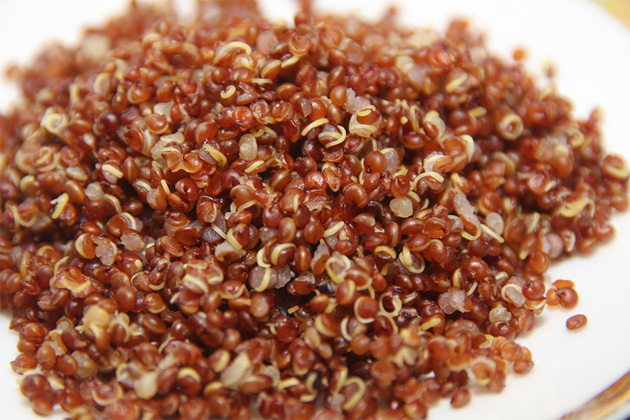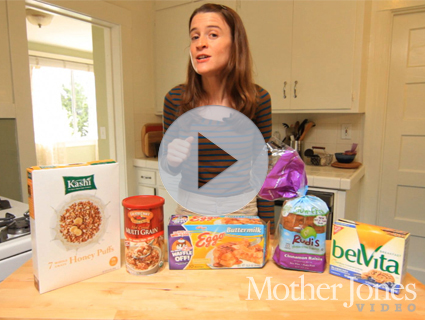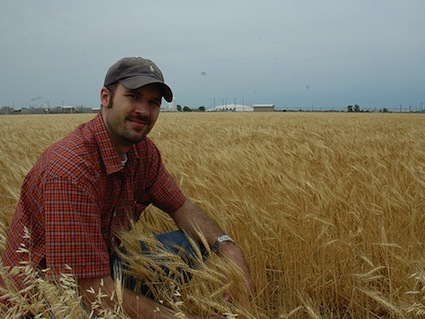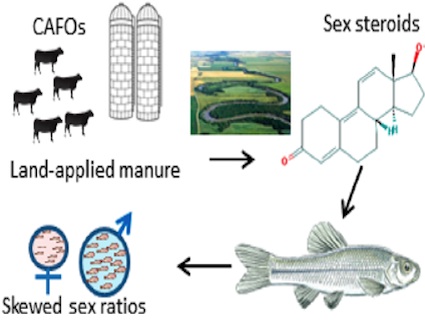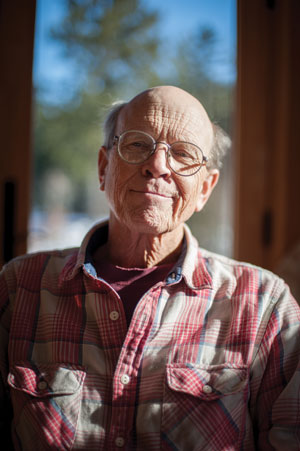
Every fall at Maine’s Common Ground Country Fair, the Lollapalooza of sustainable agriculture, John Bunker sets out a display of eccentric apples. Last September, once again, they covered every possible size, shape, and color in the wide world of appleness. There was a gnarled little yellow thing called a Westfield Seek-No-Further; a purplish plum impostor called a Black Oxford; a massive, red-streaked Wolf River; and one of Thomas Jefferson’s go-to fruits, the Esopus Spitzenburg. Bunker is known in Maine as “The Apple Whisperer,” or simply “The Apple Guy,” and, after laboring for years in semi-obscurity, he has never been in more demand. Through the catalog of Fedco Trees, a mail-order company he founded in Maine 30 years ago, Bunker has sown the seeds of a grassroots apple revolution.
All weekend long, I watched people gravitate to what Bunker (“Bunk” to his friends, a category that seems to include half the population of Maine) calls “the vibrational pull” of a table laden with bright apples. “Baldwin!” said a tiny old man with white hair and intermittent teeth, pointing to a brick-red apple that was one of America’s most important until the frigid winter of 1933-34 knocked it into obscurity. “That’s the best!”
A leathery blonde from the coast held up a Blue Pearmain in wonder. “Blue Peahmain,” she marveled. “My ma had one in her yahd.”
Another woman got choked up by the sight of the Pound Sweet. “My grandmother had a Pound Sweet! She used to let me have one every time I hung out the laundry.”
It wasn’t just nostalgia. A steady conga line of homesteading hipsters—Henry David Thoreau meets Johnny Depp—paraded up to Bunk to get his blessing on their farm plans. “I’ve got three Kavanaghs and two Cox’s Orange Pippins for fresh eating, a Wolf River for baking, and three Black Oxfords for winter keeping, but I feel like there are some gaps I need to fill. What do you recommend for cider?” Bunk, who is 62, dished out free advice through flayed vocal cords that made his words sound as if they were made of New England slate.
Most people approached with apples in hand, hoping for an ID of the tree that had been in their driveway or field ever since they bought the place. Some showed him photos on iPhones. Everywhere he travels in Maine, from the Common Ground Country Fair to the many Rotary Clubs and historical societies where he speaks, Bunk is presented with a series of mystery apples to identify. He’s happy to oblige, but what he’s really looking for are the ones he can’t identify. It’s all part of being an apple detective.
In the mid-1800s, there were thousands of unique varieties of apples in the United States, some of the most astounding diversity ever developed in a food crop. Then industrial agriculture crushed that world. The apple industry settled on a handful of varieties to promote worldwide, and the rest were forgotten. They became commercially extinct—but not quite biologically extinct.
See more apple illustrations in this short history of the seminal 100-year-old book The Apples of New York.
Even when abandoned, an apple tree can live more than 200 years, and, like the Giving Tree in Shel Silverstein’s book, it will wait patiently for the boy to return. There is a bent old Black Oxford tree in Hallowell, Maine, that is approximately two centuries old and still gives a crop of midnight-purple apples each fall. In places like northern New England, the Appalachian Mountains, and Johnny Appleseed’s beloved Ohio River Valley—agricultural byways that have escaped the bulldozer—these centenarians hang on, flickering on the edge of existence, their identity often a mystery to the present homeowners. And John Bunker is determined to save as many as he can before they, and he, are gone.
The key thing to understand about apple varieties is that apples do not come true from seed. An apple fruit is a disposable womb of the mother tree, but the seeds it encloses are new individuals, each containing a unique combination of genes from the mother tree and the mystery dad, whose contribution arrived in a pollen packet inadvertently carried by a springtime bee. If that seed grows into a tree, its apples will not resemble its parents’. Often they will be sour little green things, because qualities like bigness, redness, and sweetness require very unusual alignments of genes that may not recur by chance. Such seedling trees line the dirt roads and cellar holes of rural America.
If you like the apples made by a particular tree, and you want to make more trees just like it, you have to clone it: Snip off a shoot from the original tree, graft it onto a living rootstock, and let it grow. This is how apple varieties come into existence. Every McIntosh is a graft of the original tree that John McIntosh discovered on his Ontario farm in 1811, or a graft of a graft. Every Granny Smith stems from the chance seedling spotted by Maria Ann Smith in her Australian compost pile in the mid-1800s.
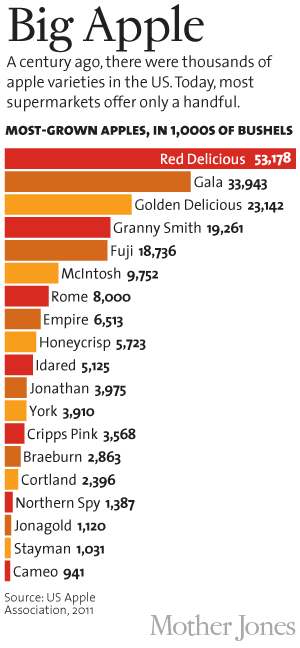
The fine points of apple sex were lost on most US colonists, who planted millions of apple seeds as they settled farms and traveled west. Leading the way was John Chapman, a.k.a. Johnny Appleseed, who single-handedly planted hundreds of thousands of seeds in the many frontier nurseries he started in anticipation of the approaching settlers, who were required to plant 50 apple or pear trees as part of their land grants. Even if they had understood grafting, the settlers probably wouldn’t have cared: Although some of the frontier apples were grown for fresh eating, more fed the hogs or the fermentation barrel, neither of which was too choosy.
Every now and then, however, one of those seedling trees produced something special. As the art of grafting spread, those special trees were cloned and named, often for the discoverer. By the 1800s, America possessed more varieties of apples than any other country in the world, each adapted to the local climate and needs. Some came ripe in July, some in November. Some could last six months in the root cellar. Some were best for baking or sauce, and many were too tannic to eat fresh but made exceptional hard cider, the default buzz of agrarian America.
Bunk called this period the Great American Agricultural Revolution. “When this all happened, there was no USDA, no land grant colleges, no pomological societies,” he says. “This was just grassroots. Farmers being breeders.” As farms industrialized, though, orchards got bigger and bigger. State agricultural extension services encouraged orchardists to focus on the handful of varieties that produced big crops of shiny red fruit that could withstand extensive shipping, often at the expense of flavor. Today, thousands of unique apples have been lost, while a mere handful dominate the market.
When Bunk lays out his dazzling apple displays, it’s a reminder that our sense of the apple has increasingly narrowed, that we are asking less and less from this most versatile of fruits—and that we are running out of time to change course. Exhibit A: The Harrison apple, the pride of Newark, New Jersey, renowned in the early 1800s for making a golden, champagne-like cider that just might have been the finest in the world. But the Harrison, like most of the high-tannin varieties that make good hard cider, disappeared after Prohibition. (The recent hard-cider revival has been making do largely with apples designed for fresh eating, which make boring cider.) But in 1976 one of Bunk’s fellow apple detectives found a single old Harrison tree on the grounds of a defunct cider mill in Livingston, New Jersey, grafted it, and now a new generation of Harrison trees is just beginning to bear fruit. It’s as if a storied wine grape called pinot noir had just been rediscovered.
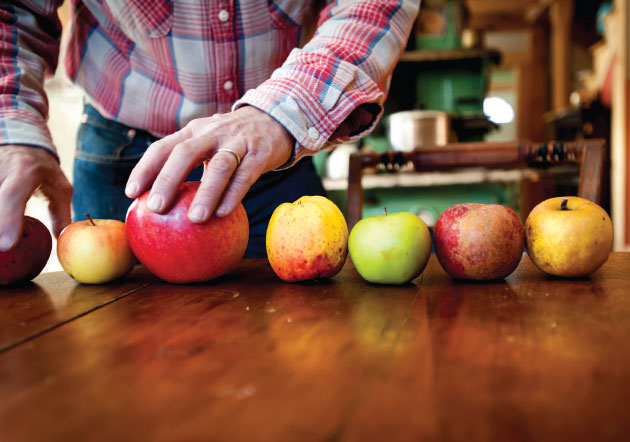
The usual argument for preserving agricultural biodiversity is that monocrops are at risk for monolithic wipeouts from pests and disease. And, indeed, some of the old apples have genes for resistance to apple scab and other scourges of the modern orchard that are proving useful. (Apples require more pesticides than any other crop, and it’s exceedingly difficult to grow modern apple varieties organically.) But don’t discount romance. The world is just a little bit more delightful when we get to experience apples with hundreds of different personalities.
Bunk’s love affair with apples dates to 1972, when he began farming a hardscrabble plot of land in the town of Palermo, Maine, after graduating from Colby College. That first fall, he noticed the apples ripening all over town, on trees that had been started decades ago and were now in their prime, that mostly went ignored. He began picking them.
“I felt like these trees I was finding in my town, and then eventually all over Maine and other places, were a gift to me by someone whom I had never met, who had no idea who I was, who had no idea that I was ever going to be.” Over time, he says, “I started thinking, I got to come to Earth and have this amazing experience of all these trees that were grown and bearing, and all these old-timers who would take me out into their fields and show me things and take me on trips down these old roads. And I would knock on somebody’s door, and the next thing you know I’m eating with them. It was like gift after gift after gift. And I started thinking, do I have any responsibilities with this? Or do I just soak it up and let it go?”
So he founded Fedco Trees, which every year takes a selection of rare heirloom apples and attempts to make them less rare. When he finds one of these missing links, he grafts it onto rootstocks at the Fedco nursery and begins selling the trees a few years later. Bunk estimates that over the past 30 years he has saved anywhere from 80 to 100 varieties from oblivion. His forensic methods involve everything from studying the depth of the cavity around the stem, to checking the trunk for grafting scars, to poring over old nursery catalogs and historical records. He hangs “Wanted” posters at corner stores in the towns where the apples originated, hands them out at historical society meetings. A typical poster reads “Wanted Alive: Narragansett Apple. Last Seen in York County!…Originated on the farm of Jacob H Harmon, Buxton, Me., in 1873.” Then, beneath a drawing and description of the apple, is the plea, “If You Know the Whereabouts of This Apple Please Contact Fedco.” He dreams of finding once-adored apples that haven’t been heard from in a century, like the Fairbanks (the pride of Winthrop, Maine) and the Naked Limbed Greening (a big green sucker from Waldo County). His current Holy Grail is the Blake, a richly flavored yellow apple so tasty it is said to have been exported to England in the 1870s. According to old catalogs and horticulture books, the Blake, with flesh that was “fine, firm, crisp, subacid,” was widely distributed in Maine in the mid-1800s. Blake trees had a distinctive habit of holding onto their apples after most others had dropped theirs. Bunk had been tantalizingly close to a positive Blake ID in December 2011, when an old tree covered with small yellow apples was spotted in a field near Portland, on land that might have been owned by a J.H. Blake in the 1870s, but the tree turned out to be a seedling, the apples didn’t quite fit, and the quest for the Blake continued.
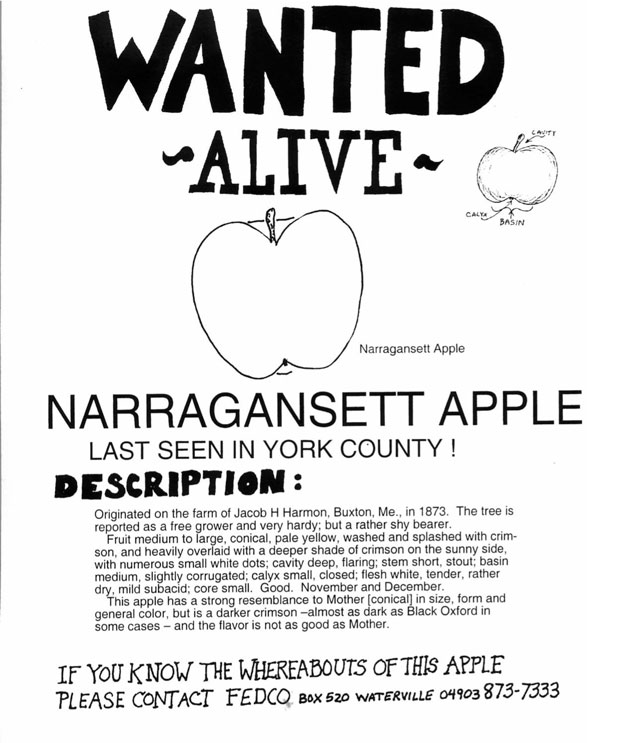
One of Bunk’s best finds was the Fletcher Sweet, which his research indicated had originated in the Lincolnville area. In 2002, he met a group from the Lincolnville Historical Society. They had never heard of the apple, but they knew of a part of Lincolnville called Fletcher Town, which, like many other old villages in northern New England, had since been reclaimed by the forest. A member of the society wrote an article for the local paper saying it was looking for an old apple called a “Fletcher.” A 79-year-old named Clarence Thurlow called the paper and said, “I’ve never heard of a Fletcher, but I know where there’s a Fletcher Sweet.”
Thurlow led Bunk to the abandoned intersection that had once been the heart of Fletcher Town, pointed to an ancient, gnarled tree, and said, “That’s the tree I used to eat apples from when I was a child.” The tree was almost entirely dead. It had lost all its bark except for a two-inch-wide strip of living tissue that rose up the trunk and led to a single living branch about 18 feet off the ground. There was no fruit, but Bunk was interested. A few months later he returned, took a handful of shoots, and grafted them to rootstock at his farm. A year later, both Thurlow and the tree died, but the grafts thrived, and a few years later, they bore the first juicy, green Fletcher Sweet apples the world had seen in years. “It’s a great apple,” Bunk says. “It has a super-duper distinctive flavor.” Today, Bunk has returned young Fletcher Sweet trees to Lincolnville.
This is the magic of apples. You can’t take a graft of Clarence Thurlow and grow a new one, but his tree was easily duplicated and returned to Maine life. Today, I can take a bite out of a Fletcher Sweet and know exactly what Thurlow was experiencing as a boy 80 years ago. I can chomp into a Newtown Pippin and understand what Thomas Jefferson was lamenting in Paris when he wrote to a friend that “they have no apples here to compare with our Newtown Pippin.”
“It’s about apples and it’s not about apples,” Bunk says of his work. “I talk about the history of apples, but you know what? I’m giving a highly political talk, because it’s about our agricultural heritage.”
And that heritage is in jeopardy. Not only has the industrial food system confined us to a meager handful of apple varieties, but many of the new apples being released, like the SweeTango, are “club apples”—intellectual property of those who bred them. Growers must sign a contract that specifies how the trees will be grown and where they can be sold, and they must pay annual royalties on every apple. The days of farmers controlling their own apples may be numbered, and the idea of breaking that chain of knowledge bothers Bunk. “When you and I interact, our ability to be together on Earth is predicated by all the stuff that people did for thousands of years,” he says. “You and I didn’t invent language. You and I didn’t invent clothes, roads, agriculture. It’s up to us to be not just the receivers of what was given to us, but the givers of whatever’s going to come next.”
By the end of the Common Ground Country Fair, I had begun to wonder if there were any more apples to rediscover. Freakish spring weather had produced the worst apple year in recent memory. Many trees had no fruit at all, and fewer people than usual were bringing Bunk their enigmas. We’d seen several Pumpkin Sweets and Roxbury Russets, along with a bushel of seedlings, but not a single tantalizing lead. Then a handsome young couple walked up to us. They looked vaguely Amish, he in a vest and straw hat, she in homespun linens. “Is there one with ‘ghost’ in the name?” the man asked. “We recently bought a place in Gardiner that has some really old trees. The 95-year-old previous owner told us the names. One was something like ‘ghost.'”
Bunk couldn’t think of any heirloom apple with a name even close to “ghost,” but a month later he made the trip to check out the ghost apple. As soon as he saw the Gardiner house he grew hopeful. It was a classic old Cape and barn, and there was a row of some of the oldest pear trees he’d ever seen in the front yard. Fifty-foot crab apple trees shaded the house.
Skinny maples had colonized the land behind the house, but at regular intervals between them, in an orderly grid, he could make out the dark bulk of ancient revenants. It was an old orchard of about 30 trees. Most were dead. Some had gradually lain down on the ground and were now melting back into the earth.
The Ghost, it turned out, was a Snow, the name misremembered. A bright red Canadian apple cultivated by French settlers in the 1600s, the Snow is fairly common, though it’s best known as the mother of the McIntosh. It is named for its snow-white flesh. “Or ghost-white,” Bunk mused. He identified a brown, fuzzy Roxbury Russet, the oldest apple variety in America, also not an unusual find. He didn’t feel particularly disappointed; most leads go nowhere.
Then, along the back edge of the old orchard, he came upon a gnarled tree that was at least 150 years old. It held no fruit, but on the ground beneath it lay two dozen golden apples. Bunk picked up one and turned it over in his hand. It was round and firm, with prominent russet dots and a splash of russet around the stem. He knew instantly that he’d never before seen this apple, and, with a thrill, he also instantly wondered whether he had just found the Blake at last. Very few truly yellow apples were grown in Maine 150 years ago. But was the flesh “fine, firm, crisp, subacid”? He bit into the apple. Check, check, check, check. It would take a lot more detective work to prove this was a Blake, and he would have to return next fall to get some fruit in better condition, but he had a strong hunch that this ghost of the Great American Agricultural Revolution was a ghost no more.
